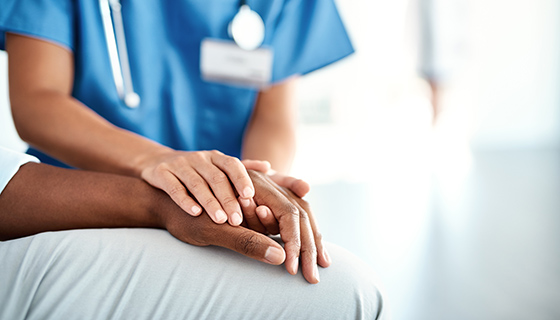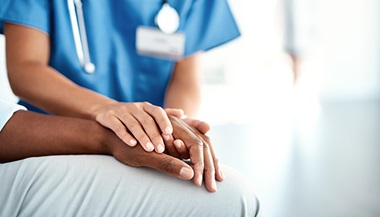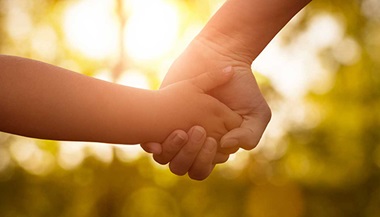Clubhand
What You Need to Know
- Congenital clubhand is a hand difference that is present at birth. Acquired clubhand can occur later in life from an injury or infection.
- Clubhand isn’t typically painful. However, the condition may affect a person’s ability to use their wrists, hands and fingers.
- Clubhand treatments include surgery, physical and occupational therapies, and splints and casts.
What is clubhand?
Clubhand is a type of hand difference in which one or both wrists are fixed in a bent position. This bend causes the hand to curve toward the forearm (lower arm), creating a club or j-shaped appearance. Clubhand is less common than clubfoot.
Typically, people who have clubhand are born with it — this is called congenital clubhand. Less commonly, a person develops clubhand after a traumatic injury or infection — this is called acquired clubhand.
Clubhand usually isn’t painful, but the condition may affect a child’s ability to use wrists, hands and fingers. In more severe cases, clubhand can also affect elbow movement. Some children with clubhand have short or missing thumbs or fingers.
Types of Clubhand
Clubhand may occur in one hand (unilateral clubhand) or both hands (bilateral clubhand). It can affect one or both of the following bones in the forearm that help rotate, bend and move wrists and hands.
- Radius: This short, inner forearm bone is on the thumb side of the hand.
- Ulna: This longer, outer forearm bone runs parallel to the radius on the little finger side of the hand.
Based on which bones are affected, there are two main types of clubhand: radial clubhand and ulnar clubhand. Each type has different subtypes that indicate the condition’s severity. Type 1 clubhand is the mildest. Type 4 clubhand is the most severe.
Radial Clubhand
Radial clubhand is the most common type. It affects approximately one in 55,000 newborns each year. This condition causes the wrist and hand to bend toward the radius (thumb) side of the arm. Radial dysplasia and radial longitudinal deficiency are other names for radial clubhand.
The four subtypes of radial clubhand are:
- Type 1. A slightly shorter radius causes the wrist to turn in a little. Also, the thumb may be shorter than usual. Most children with this mild type of radial clubhand have typical use of their hands and may not need treatment.
- Type 2. A too-short radius causes a slight bend in the wrist. Often, the thumb is shorter than usual.
- Type 3. Most of the radius is missing. The wrist and hand bend severely toward a short or missing thumb. The ulna is thick and curved.
- Type 4. The radius is completely missing. As a result, the wrist and hand bend significantly toward a short or missing thumb. Some fingers may also be short or missing, and the elbow may not bend as it should.
Ulnar Clubhand
Ulnar clubhand causes the wrist and hand to bend toward the small finger side of the arm. It affects approximately one in 100,000 newborns each year. Ulnar dysplasia and ulnar longitudinal deficiency are other names for ulnar clubhand.
The four subtypes of ulnar clubhand are:
- Type 1. The ulna is a little shorter than usual, causing a slight outward bend in the wrist. Most children with this mild type of ulnar clubhand can use their hands as expected. They may not need treatment.
- Type 2. Part of the ulna is missing. There’s also a curve in the radius and an abnormal band of fibrous tissue (anlage) connecting the ulna and wrist bones. There’s a more noticeable outward bend in the wrist too. Some fingers may be missing or shorter than usual.
- Type 3. The ulna is completely missing, causing a significant outward bend in the wrist. Some fingers may be missing or shorter than usual.
- Type 4. The ulna is completely missing. There’s a significant forearm curve and a bend in the wrist. The long bone in the upper arm (humerus) improperly fuses with the radius, which prevents elbow movement. Some fingers may be missing or shorter than usual.
What causes clubhand?
There is often no known reason for congenital clubhand — something affects bone formation while a baby develops in the womb. Clubhand is not caused by actions of the mother while pregnant. Acquired clubhand can develop after an injury or infection later in life, and it is less common.
Clubhand sometimes affects more than one member of a family, although experts are not sure why. In some instances, clubhand occurs with other developmental anomalies, such as:
- Trisomy 21 (Down syndrome)
- Trisomy 13 (Patau syndrome)
- Trisomy 18 (Edwards syndrome)
- Holt-Oran syndrome (heart-hand syndrome)
- VACTERL association (VATER syndrome)
Clubhand Symptoms
Clubhand causes different symptoms depending on the type and severity (subtype). A child may have:
- Fixed bend in wrist and hand
- Inflexible elbow
- Missing forearm bones
- Short or curved forearm
- Small or missing thumb or fingers
Diagnosing Clubhand
A prenatal ultrasound can sometimes detect clubhand in an unborn baby. A doctor or nurse may notice the hand difference at birth. If a doctor suspects clubhand, X-rays can determine the type and subtype. A doctor will also perform a full physical examination and may order more tests if other developmental anomalies are suspected.
Clubhand Treatments
A child may need one or more treatments, depending on the clubhand type and subtype, function of the thumb, stability of the joints and other factors. Treatments may include:
Physical and Occupational Therapies
Physical therapy and hand therapy (a form of occupational therapy) are often the main treatments for mild cases of clubhand. The exercises start soon after birth and focus on stretching and gently aligning the bones in the hand and arm, which can help correct the hand difference without surgery. Therapists demonstrate exercises and teach parents how to do them with children at home. A child with more severe clubhand may receive these therapies before and after surgery.
Physical therapy can also help improve hand, wrist and elbow movement, while occupational therapy can help children with limited hand function learn how to complete daily tasks such as getting dressed.
Clubhand Splints and Casts
A child may need to wear a splint or cast, usually overnight, to gently stretch tissues in the forearm into a straighter position. Combined with physical and occupational therapy, a splint or cast may help correct mild hand differences. Children who need surgery may also require a splint or cast before and after corrective surgery, as the bones and tissues heal.
Clubhand Surgery
Children with severe clubhand need surgery to improve wrist and hand function. Surgery may take place in stages starting around age 1.
Radial clubhand can be surgically treated with:
- This procedure moves the wrist bones (carpus) and centers them with the end of the ulna bone. The tissues that hold the relocated bones in place help pull the hand into a straighter position.
- This procedure moves the wrist bones and connects them with the ulna bone where the radius would connect. A surgeon also moves muscles from the radius to the ulna to help pull the hand into a straighter position.
- This procedure moves the wrist bones and connects them with the ulna near the side where the thumb would be. It can help decompress the nerves and arteries that pass through the wrist. This approach is less common than centralization and radialization.
- Soft tissue centralization (bilobed flap). A surgeon repositions the muscles, tendons and other soft tissues in the wrist to straighten the hand-forearm alignment and improve range of motion. Bones are not cut or moved, but skin needs to be cut and repositioned during this procedure.
Ulnar clubhand can be surgically treated with:
- Creation of a one-bone forearm. A surgeon reshapes the bones to connect the radius to the ulna end to end or side to side, merging them into one bone, which can offer a better use of the arm and hand.
- Removal of anlage. The fibrous tissue that tethers the ulna to the wrist is fully or partially removed to help reduce bowing.
Other types of surgery that treat conditions associated with clubhand include:
- A surgeon cuts the forearm bone to reshape and straighten it. Removable pins hold the bones in place while they heal.
- External distraction (lengthening) devices can be used to straighten the curved radius or ulna. During this short procedure, metal wires are threaded through the bone and connected to an outside metal frame. At home, parents can turn the knobs on the frame to tighten and loosen the wires per the surgeon’s instructions, which helps reduce bowing over time by stretching and rotating the bones.
- Elbow surgery. A surgeon cuts and releases tight tissues in the back of the elbow to improve mobility.
- Syndactyly release. This procedure separates fused fingers.
- Thumb surgery:
- Pollicization surgery. A surgeon moves a child’s index finger or another finger to the thumb position to replace a missing thumb.
- This tendon transfer surgery strengthens the muscles in a slightly short thumb.
Living with Clubhand
A child with clubhand can learn to do most tasks with the affected hand or use an alternative method learned in occupational therapy. Most children will need physical therapy throughout their life to maintain range of motion.
Early clubhand treatment, including well-timed surgery, can help correct the hand’s bent appearance and improve hand function. However, bone growth disruption is a risk from performing surgery on growing bones. These children may grow up to have discrepancy in arm length, as well as stiffness in the wrist and fingers. In some cases, the bowing of the bones may continue after the initial treatment, requiring additional procedures.
Correcting acquired clubhand or untreated congenital clubhand can be more difficult in adults than in children. However, surgery and therapies can help.






